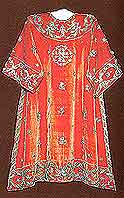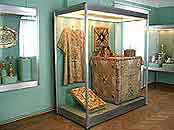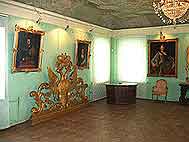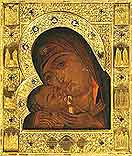The Sacristy of the Trinity-St. Sergius Lavra of the 14th - 19th cc. (Page 4)
 The part of the exposition, dedicated to the Synod period (1721 – 1918), is housed in the Vicegerent Chambers conned with the Sacristy by a passage. At that time the Monastery Cathedrals, Sacristy and new palaces and residences were decorated according to the contemporary fashion and taste. The prevailing decorative monuments were icons, icon and ornamental embroideries, books, church objects of precious metals. The most remarkable monument is the set of church vestments embroidered in pearls. “The Pearl Sacristy” was commissioned by Catherine II and made to the order of the Trinity Archimandrite Platon Levshin. They used the old Monastery pearls from ancient icon-cloths. The frontal “The Cross on Golgotha” for the Trinity Cathedral and the shroud “The Entombment”, made to Platon Levshin’s order, are fine works of the late 18th century art.
The part of the exposition, dedicated to the Synod period (1721 – 1918), is housed in the Vicegerent Chambers conned with the Sacristy by a passage. At that time the Monastery Cathedrals, Sacristy and new palaces and residences were decorated according to the contemporary fashion and taste. The prevailing decorative monuments were icons, icon and ornamental embroideries, books, church objects of precious metals. The most remarkable monument is the set of church vestments embroidered in pearls. “The Pearl Sacristy” was commissioned by Catherine II and made to the order of the Trinity Archimandrite Platon Levshin. They used the old Monastery pearls from ancient icon-cloths. The frontal “The Cross on Golgotha” for the Trinity Cathedral and the shroud “The Entombment”, made to Platon Levshin’s order, are fine works of the late 18th century art.
 The patterns of pearl embroidery on the shoulder-pieces of the church vestments look like stucco molding according to the new tendencies of that time. The luxurious church vestments of velvet and brocade present fine samples Russian precious textiles that were as artistic as European fabrics.
The patterns of pearl embroidery on the shoulder-pieces of the church vestments look like stucco molding according to the new tendencies of that time. The luxurious church vestments of velvet and brocade present fine samples Russian precious textiles that were as artistic as European fabrics.
 The collection includes a lot of works of Moscow and St. Petersburg silversmiths of the 18th – 19th century. They achieved success in different jewelry art techniques: chasing, niello, enamel, etc. Chasing was a preferable technique. Its patterns were considerably changed. They were composed of large baroque scrolls, shells, baskets with flowers and fruit made in high relief. The mounting for the Gospel of 1754 is decorated with intricate chased pattern, which is harmoniously supplemented with enamel plaques with fine miniatures. The 18th filigree patterns differ from the patterns of the previous epoch. They are more complicated. The ornaments are used in many layers and combined with enamel and precious stones. The reliquary of 1789, which once belonged to Metropolitan Platon, is a unique specimen of that time. Its shape and refine decoration make it look like a precious casket.
The collection includes a lot of works of Moscow and St. Petersburg silversmiths of the 18th – 19th century. They achieved success in different jewelry art techniques: chasing, niello, enamel, etc. Chasing was a preferable technique. Its patterns were considerably changed. They were composed of large baroque scrolls, shells, baskets with flowers and fruit made in high relief. The mounting for the Gospel of 1754 is decorated with intricate chased pattern, which is harmoniously supplemented with enamel plaques with fine miniatures. The 18th filigree patterns differ from the patterns of the previous epoch. They are more complicated. The ornaments are used in many layers and combined with enamel and precious stones. The reliquary of 1789, which once belonged to Metropolitan Platon, is a unique specimen of that time. Its shape and refine decoration make it look like a precious casket.
 Alongside with church utensils, commissioned by the Monastery authorities, there are paintings, pieces of furniture, lamps, objects of everyday life from the living chambers of the Lavra clergy. Ivan Nikitin, an outstanding artist, a founder of Russian realistic portrait painting, is considered to be the author of the portrait of Tsarina Praskovia Feodorovna Saltykova, the wife of Peter the Great’s brother - Ivan Alexeyevich. The portraits of Elizaveta Petrovna and Peter III were painted by Alexei Antropov, a brilliant representative of the baroque period. At that time gala portraits were very popular. Their main task was to demonstrate the position of the portrayed in the society.
Alongside with church utensils, commissioned by the Monastery authorities, there are paintings, pieces of furniture, lamps, objects of everyday life from the living chambers of the Lavra clergy. Ivan Nikitin, an outstanding artist, a founder of Russian realistic portrait painting, is considered to be the author of the portrait of Tsarina Praskovia Feodorovna Saltykova, the wife of Peter the Great’s brother - Ivan Alexeyevich. The portraits of Elizaveta Petrovna and Peter III were painted by Alexei Antropov, a brilliant representative of the baroque period. At that time gala portraits were very popular. Their main task was to demonstrate the position of the portrayed in the society.
 The items of the New Time collection show a logical development of the medieval complex which was historically formed in the Monastery. “The Sacristy of the Trinity-St. Sergius Lavra of the 14th – 19th cc.” of the Sergiev Posad Museum-Reserve, presenting the first-rate works of art, gives a vivid idea of Russian artistic life in the course of several centuries.
The items of the New Time collection show a logical development of the medieval complex which was historically formed in the Monastery. “The Sacristy of the Trinity-St. Sergius Lavra of the 14th – 19th cc.” of the Sergiev Posad Museum-Reserve, presenting the first-rate works of art, gives a vivid idea of Russian artistic life in the course of several centuries.
|


